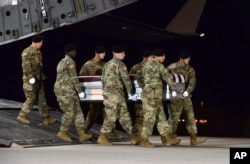New details are emerging about the attack that left four U.S. soldiers dead in Niger as U.S. congressional leaders are demanding answers from the Pentagon.
The four U.S. service members, three of whom were Green Berets (special forces), along with four Nigerian soldiers were killed on October 4 in an ambush in Tongo-Tongo, a village near the border with Mali.
On the eve of the attack, about 30 Special Forces, mostly Nigeriens and eight U.S. Green Berets, set off in pickup trucks toward the border village and arrived at night, according to Almou Hassane, mayor of Tongo-Tongo, in the Tondikiwindi district.
“They must have spent the night in the northwest of Tongo-Tongo,” Mayor Hassane said in a phone interview with the VOA French-to-Africa service.
"These Nigerien soldiers are part of a security and intelligence battalion that has been trained by the U.S. forces during several U.S.-led training exercises known as Flintlock," said Moussa Aksar, director of the newspaper l'Évènement in Niamey, and a terrorism specialist in the Sahel.
The soldiers were trying to track down an accomplice of Abu Adnan al-Sahraoui, a former member of the Movement for Unity and Jihad in West Africa (MUJAO), who joined the Islamic State terror group in the Sahara Desert.
The soldiers questioned the villagers, who dragged on the discussions longer than anticipated.
“It turns out that this village was a little contaminated by hostile forces,” said Aksar. “The unit stayed a little longer than expected because apparently people were aware that something was going on."
For his part, Mayor Hassane said, “The attackers, the bandits, the terrorists have never lacked accomplices among local populations.”
A fake terror attack attracted the soldiers to a trap outside the village, where about 50 assailants in vehicles and motorcycles armed with Kalashnikovs and heavy weapons opened fire on them. Four Nigerien soldiers and three Americans were killed on the spot. The body of the fourth American soldier was found 48 hours later, about a mile away from the initial site, CNN reported.
“We are not talking about civilians wounded or killed because these soldiers were ambushed outside the village,” Aksar said.
The attack has raised questions, especially since the U.S. Army operates drone bases in Niger and has significant intelligence resources there.
“That's what really shocked us: how, at their level, with all the resources they have, they could not have strong intelligence to avoid what happened there,” said Hassane.
Since the attack, Tongo-Tongo village chief Mounkaila Alassane has been arrested, and there is no information on his whereabouts.
No group has officially taken responsibility for the attack. According to sources in the region, however, it is the work of Abu Adnan al-Saharaoui, who calls himself the Islamic Emir of the Great Sahara, affiliated with the Islamic State group.
According to a Tuareg from the region, al-Saharaoui is reported to be involved in arms and fuel trafficking. He is a former member of the Movement for Unity and Jihad in West Africa (MUJAO), which occupied and imposed sharia law in northern Mali in 2012 before being dislodged by French forces.
Al-Saharaoui, a former acquaintance of Algerian extremist and trafficker Mokhtar Bel Mokhtar, had led the kidnapping of the nine-person staff of the Algerian consulate in Gao in 2012. Originally from Western Sahara, he wants to control the band on the common border of Burkina Faso, Mali and Niger.
“He wants to take control of all these communities facing poverty and governance issues so that they can join his cause,” said Aksar.
The group is the latest of several jihadist organizations in the Sahel region, including the Defenders of Islam group linked to militant Iyad Ag Ghali in northern Mali. The movement for the Liberation of Macina, led by Hamadoun Koufa, remained very active in central Mali.
Ansarul Islam, on the other side of the border, is increasing its attacks in northern Burkina Faso, while Boko Haram continues to launch attacks in the countries in Africa's Lake Chad Basin.
The al-Mourabitoun group, which is led by Moktar Belmokhtar — declared dead several times — has perpetrated several terror actions in the vast Sahel region, including the 2013 attack on the In Amenas gas plant in Algeria that left 67 people dead.










